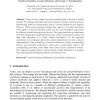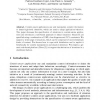DAIS
2006
14 years 28 days ago
2006
Abstract. In this paper, we define a model-driven design trajectory for contextaware services consisting of three levels of models with different degrees of ion and platform indepe...
DAIS
2006
14 years 28 days ago
2006
Abstract. In this paper, a model is presented which allows the composition of web services by means of a special web service, named WSInterConnect. Such a service might be used in ...
DAIS
2007
14 years 1 months ago
2007
Constructing and executing distributed applications that can adapt to their current operating context, in order to maintain or enhance Quality of Service (QoS) attribute levels, ar...
DAIS
2007
14 years 1 months ago
2007
Implementing context-dependent behaviour of pervasive computing applications puts a great burden on programmers: Devices need to continuously adapt not only to their own context, b...
DAIS
2007
14 years 1 months ago
2007
Today, one can observe an ever increasing trend in the use of mobile systems. This change inevitably affects the software running on such devices by necessitating additional functi...
DAIS
2007
14 years 1 months ago
2007
The present emergence of loosely-coupled, inter-enterprise collaboration, i.e., virtual organizations calls for new kind of middleware: generic, common facilities for managing cont...
DAIS
2007
14 years 1 months ago
2007
Abstract. Replication systems require a state-transfer mechanism in order to recover crashed replicas and to integrate new ones into replication groups. This paper presents and eva...
DAIS
2007
14 years 1 months ago
2007
Because they are required to support component deployment and composition, modern execution environments embody a number of common features such as dynamic linking and support for ...
DAIS
2007
14 years 1 months ago
2007
Context-aware applications use and manipulate context information to detect high-level situations, which are used to adapt application behavior. This paper discusses the specificat...
DAIS
2007
14 years 1 months ago
2007
Abstract. Ubiquitous computing environments are characterised by a high number of heterogenous devices that generate a huge amount of context data. These data are used, for example...



